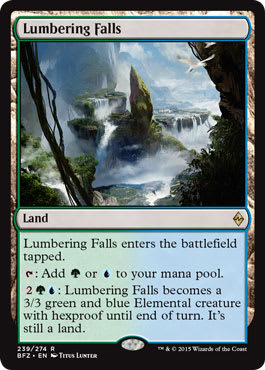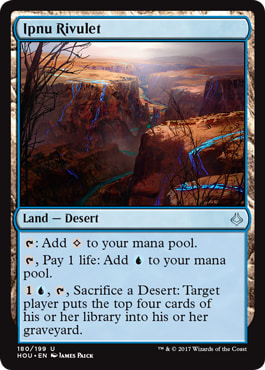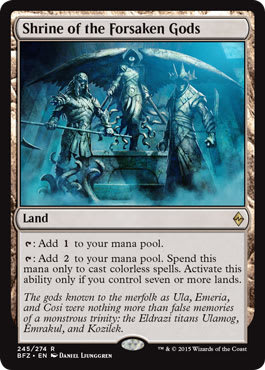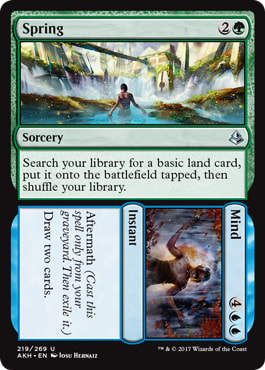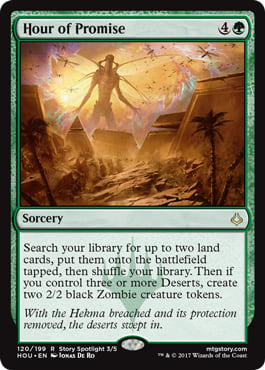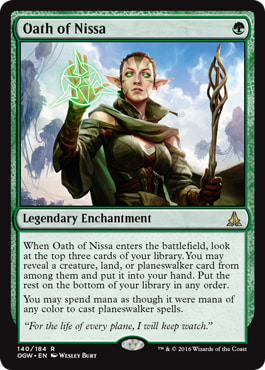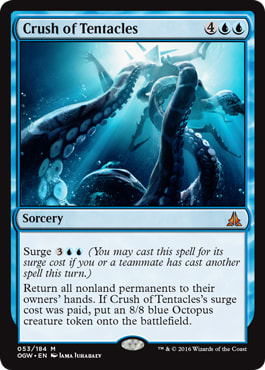A few weeks ago, Roman Fusco, my young apprentice and partner on the Ancestral Recall podcast made Top 8 of the Standard Classic at the most recent Star City Invitational. A Classic Top 8 is not, in and of itself, so remarkable (there are, after all, something like sixty-four on average per month) . . . But Roman’s deck was meaningfully different than anything that had performed in Standard for what seemed like aeons.
Bant Delirium ? Amonkhet Standard | Dan Ward and Roman Fusco
- Creatures (16)
- 1 Bruna, the Fading Light
- 1 Gisela, the Broken Blade
- 1 Ishkanah, Grafwidow
- 1 Linvala, the Preserver
- 1 Ulamog, the Ceaseless Hunger
- 3 Tireless Tracker
- 4 Primal Druid
- 4 Thraben Inspector
- Instants (4)
- 1 Immolating Glare
- 3 Dissenter's Deliverance
- Sorceries (14)
- 1 Descend upon the Sinful
- 2 Nissa's Renewal
- 3 Fumigate
- 4 Spring // Mind
- 4 Traverse the Ulvenwald
- Enchantments (5)
- 1 Quarantine Field
- 4 Cast Out
- Lands (21)
- 2 Island
- 3 Plains
- 6 Forest
- 1 Irrigated Farmland
- 1 Lumbering Falls
- 2 Evolving Wilds
- 2 Scattered Groves
- 4 Fortified Village
Roman’s deck, built with his Regional Finals opponent and PT veteran Dan Ward, was a vision. So card advantageous; so solid on its fundamentals. So synergistic; such an impressive high end. The deck combined speed bumps in the form of Thraben Inspector and Primal Druid (to buy time while building advantages) with the most powerful finishers in the post-Aetherworks Marvel Standard. Traverse the Ulvenwald was in full effect in Roman’s deck, with four copies making everything from the singleton Ulamog, the Ceaseless Hunger to the Gisela + Bruna combo so accessible.
For a format dominated by a small number of decks, the very existence of Bant Delirium was a triumph. But looking at the deck, looking at the details and what it did, I saw something more:
The Next Chapter
Look for a moment at this deck. This is a deck that hard-casts Ulamog, the Ceaseless Hunger . . . With no Aetherworks Marvel, no degenerate mana base, no brand spanking Reason // Believe, even. It does so with light help from Spring // Mind and a heavier hand in Nissa's Renewal. Looking at those cards, are there any three sweeter prophecies to ponder than
Roman and I set off to update the deck.
Hour of Promise demanded a few things that we’ll get into later . . . Some Deserts; some specialty accelerators. For our first few drafts, that made adhering to Roman’s Bant structure quite clunky. Thraben Inspector absorbs way less damage when starting on turn two, for instance.
I won’t bore you with the set after set of barely-break-even testing against Golgari Energy and Mardu Vehicles. I settled, eventually, on a Simic build built for speed and power. For our purposes today and tomorrow, let’s call it this:
Hour of the Waterveil ? Hour of Devastation Standard | Michael Flores
- Creatures (13)
- 1 Ulvenwald Hydra
- 4 Primal Druid
- 4 Shefet Monitor
- 4 Ulamog, the Ceaseless Hunger
- Instants (1)
- 1 Dissenter's Deliverance
- Sorceries (21)
- 1 Beneath the Sands
- 4 Crush of Tentacles
- 4 Hour of Promise
- 4 Part the Waterveil
- 4 Spring // Mind
- 4 Traverse the Ulvenwald
- Enchantments (4)
- 4 Oath of Nissa
- Lands (21)
- 3 Island
- 6 Forest
- 1 Desert of the Indomitable
- 1 Ipnu Rivulet
- 2 Hashep Oasis
- 4 Lumbering Falls
- 4 Shrine of the Forsaken Gods
- Sideboard (15)
- 4 Jace's Defeat
- 1 Pull from Tomorrow
- 1 Dissenter's Deliverance
- 3 Tireless Tracker
- 2 Ishkanah, Grafwidow
- 4 Oblivion Sower
What do I mean by speed and power?
Speed — sixteen of the twenty-one lands in this deck enter the battlefield untapped. Four of the lands tap, at least potentially, for two mana. While the deck has the highest of high ends, it can tap out every turn from turn one, often actually advancing its position on the battlefield. It can close out games with tremendous efficiency — over as few as just one or two attacks — and also answer the opponent’s offense with speed bumps like Primal Druid or a pair of Zombie tokens. The biggest speed differentiator between this Simic build and Roman’s Bant is the presence of all four copies of Ulamog, the Ceaseless Hunger and all four copies of Shrine of the Forsaken Gods. That redundancy means deck doesn’t need to take a turn off to cast Traverse the Ulvenwald the way the Bullet Bant did . . . And in fact that might be even more time savings than I’m implying now. Mine is not an outstanding Traverse deck in terms of Delirium (though it will often surprise you in a pinch).
Power — The power of this deck should be fairly self-evident. It has four copies of Ulamog, the Ceaseless Hunger, true . . . But above and beyond those ten drops, it has the most powerful offensive and defensive capabilities in Standard. Part the Waterveil ain’t no joke. Beyond just winning the game by itself (especially when drawn in multiples), this Simic build has a variety of cheap triggers for Crush of Tentacles. Crush is one of the most criminally underrated cards in Standard. It can answer anything (ever make them pick up their Cast Out?) or tempo any number of small weenies . . . All while leaving an 8/8 creature! Crush of Tentacles is your ace in the hole. If you can resolve it, it can answer Planeswalkers or other troublesome permanents without devoting a lot of space (especially main deck) to a lot of different kinds of hosers.
The Big Payoffs (and how to get there)
The card that laces this entire deck together is Hour of Promise. The most powerful impact of Hour of Promise is in driving a fast Ulamog, the Ceaseless Hunger.
You start with five mana to cast Hour of Promise; in theory you can get two lands (going to seven total mana). More exciting is to make sure you get two copies of Shrine of the Forsaken Gods. That is still seven mana . . . Unless you’re going to cast Ulamog!
Your “nine” mana dovetails directly into ten with any untapped land coming down for your next turn. Ulamog!
Just casting Ulamog will generate a huge advantage most of the time. Unless the opponent plays with Summary Dismissal, they will usually lose at least two lands and go down three-for-one. There are some possibilities . . . The opponent can cast a Disallow and another permission spell, for instance, to stop your exile trigger and deal with the big body. But even that requires about six open mana and costs them two cards.
You can win with just Part the Waterveil (the same way you can win with just Ulamog), but these two cards are often best together. The reason? Few can withstand Ulamog attacking twice. But in a deck with Ipnu Rivulet?
More on that later.
The Mana Base
It’s later!
The capability of every single deck that has ever existed in Magic: The Gathering is defined by its mana base . . . This one especially so.
The inspiration for this deck was Roman Fusco’s Bant deck from the SCG Classic, and the new Hour of Devastation card Hour of Promise is the glue putting it all together, but the layers and nuances of the deck’s mana base go much, much further. It’s not just a question of having some Deserts for Hour of Promise’s Zombie tokens . . . It’s how many Deserts, and which ones? What do they tap for? What do they produce?
Shrine of the Forsaken Gods is a tent pole holding up the mana base, too. The philosophy of going fast demands you play with all four copies, even though we have Hour of Promise to help find them . . . In our twenty-one land deck, that puts a severe limitation on our colored mana, specifically our basic lands.
Let’s begin, shall we?
4 Lumbering Falls
I’ve toyed with various options for these slots, but have consistently come back to the full four copies of Lumbering Falls. Lumbering Falls is in some wise the weakest land in the deck (it comes into play tapped) but is important — more even than for its hexproof offense — for its mana fixing.
The Deserts
I tested mostly with three copies of Hashep Oasis, but wanted to try one copy of a cycling Desert. The reason? Delirium. That doesn’t make a huge amount of sense, ultimately. You can’t really Traverse the Ulvenwald for the Desert of the Indomitable to get an essential land in the graveyard to give yourself Delirium. If you try this deck, I think three copies of Hashep Oasis might just be better . . . You can keep a one Hashep Oasis hand with a bunch of 1-drop Green cards and have a reasonable chance of curving out, after all.
Ipnu Rivulet is subtly one of the most important cards in the deck. I added it originally as just a Blue Desert that entered the battlefield untapped (for either Shefet Monitor or just for speed purposes) but it turns out the Millstone tech is very valuable. Not only does the Millstone option put a land in your graveyard (which might help out Delirium) but consecutive Ulamog attacks + an Ipnu Rivulet activation or two will usually end it. It’s hard to believe how relevant the cards you are getting from the Rivulet are, but I would estimate I win a third or more of my games with this deck by using it.
4 Shrine of the Forsaken Gods
Kind of the whole point!
The Basic Lands
- 6 Forest
- 3 Island
The mana base definition starts at twenty-one slots. Everything is a countdown from there. Three Islands is the bare minimum for a deck full of this much searching (you need to be able to search for ![]()
![]()
![]() in some games). That leaves all the balance of the lands as Forests.
in some games). That leaves all the balance of the lands as Forests.
Thirteen sources of Green is a little thin. I would really like to get one more Green mana in, but you almost have to cut a Shrine of the Forsaken Gods (or add a twenty-second land). There is tons of Oath/Traverse/search action . . . But you need the first Green to start the snowball effect.
When actually playing a deck like this, much of the skill is in which land you search for, when. Most of the time, for instance, it is preferred to use Shefet Monitor to get Deserts, which leaves basics for your Traverse, Spring // Mind, etc. That is not always the case, though. For example, if you have one Island on the battlefield, you might want to get another Island with Shefet Monitor (which would put you from four to five, implying six on your next turn) if your planned sequence is Oath of Nissa + Crush of Tentacles [as that will save you one life point]. It is really, really important to lock down which lands to get when, as the difference in life points via Deserts and Zombie tokens both can be determining factors in close games.
On that note, the one land I wish I had a copy of is Evolving Wilds. The problems are 1) adding a land that enters the battlefield tapped will slow the deck down, and 2) there is enough pressure on the mana base already! I’ve played (and thankfully won) more than one game where I had no more basic lands to search up. Evolving Wilds puts additional pressure on this resource in your deck with few or other relevant synergies.
At twenty-one lands, I think the right mix would be to swap the cycling Desert for a third untapped Green + swapping one Shrine of the Forsaken Gods for one Evolving Wilds. Yes, I hate that, too.
Key Play Patterns
Spring // Mind → Hour of Promise
This is one of the basic ones. You go three to four, play your land, and hit five for hour. Simple, right? That (or a proxy of Druid or cycling fifth) can give you a turn five Ulamog, though.
Shefet Monitor → Hour of Promise
This works even if you miss your “fifth” land drop. The advantage of this sequence is that you can almost always land the first Desert, so if you need the defense you can always have all three in play the next turn. Super important: Shefet Monitor gives you untapped lands! So for instance if you have exactly four mana in play you can Monitor for a Forest and discard Dissenter's Deliverance, putting both creature and instant into your graveyard. It’s relevant with Jace's Defeat after sideboarding if you have five untapped, too, especially if you aren’t starting with an untapped Blue source.
Oath of Nissa → Crush of Tentacles
This is often precipitated by a Shefet Monitor (three to five). Basically, on six mana you can play your Oath of Nissa and then surge your Cursh. The re-buy aspect of Oath of Nissa is especially valuable. At seven mana Oath → Crush → Oath feels indomitable . . . Especially if the Oath gets you a guy instead of a land. Card advantage and all that.
Ulvenwald Hydra → Shrine of the Forsaken Gods
Roman played Nissa's Renewal in his Bant Classic. We are filling the six with a creature for multiple reasons. You only get one land, but you get a ginormous guy along with it. This doesn’t work all the time, but especially when you already have a Shrine, you can be in Ulamog mode in no time. There is an argument to be made for one Mirrorpool; because if they let you go Hydra → Mirrorpool and then untap . . . I really don’t see how you’re losing.
Conclusion, for Now
This deck is really powerful, and non-intuitive. One of Roman’s first thoughts was that it would be soft to control decks, especially Counterspell decks like ![]()
![]() . . . It turns out that you almost can never lose those matchups! The advantage against slow is massive! We also played heads up against his original Bant deck . . . No kind of midrange deck can really keep up on power level. There is some question around the beatdown (which we’ll just start to explore in the next installment) . . . But the great thing is, the deck isn’t done yet.
. . . It turns out that you almost can never lose those matchups! The advantage against slow is massive! We also played heads up against his original Bant deck . . . No kind of midrange deck can really keep up on power level. There is some question around the beatdown (which we’ll just start to explore in the next installment) . . . But the great thing is, the deck isn’t done yet.
Tomorrow we’ll go over the first ten matches I played with it on Magic Online. See you then!
LOVE
MIKE













